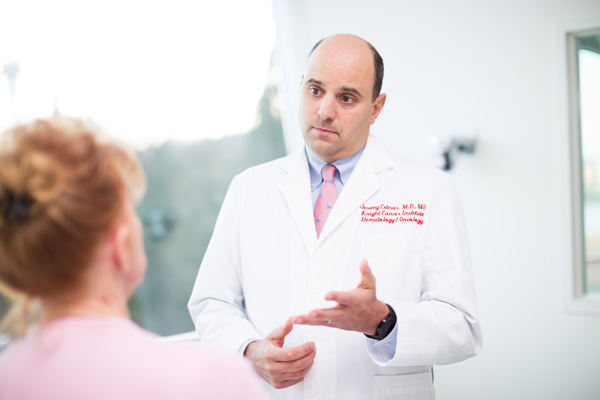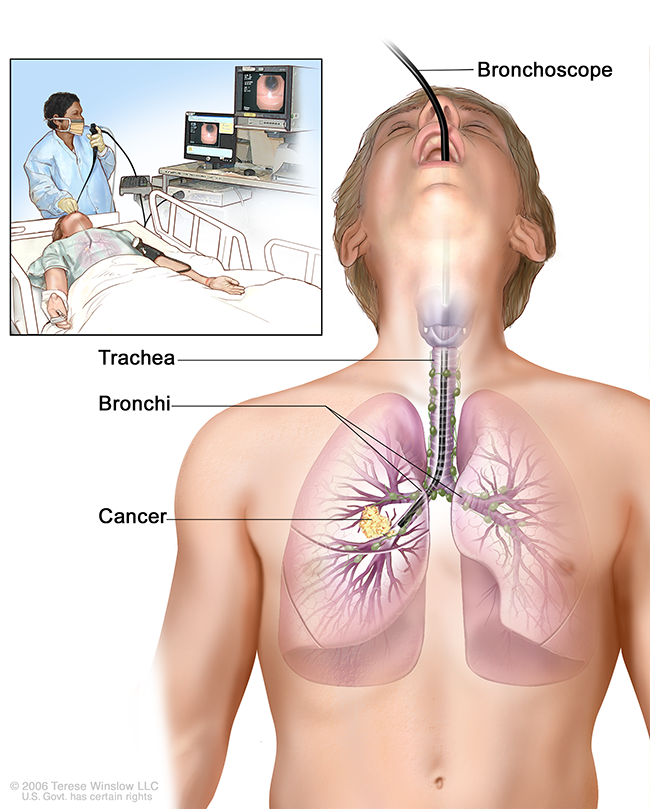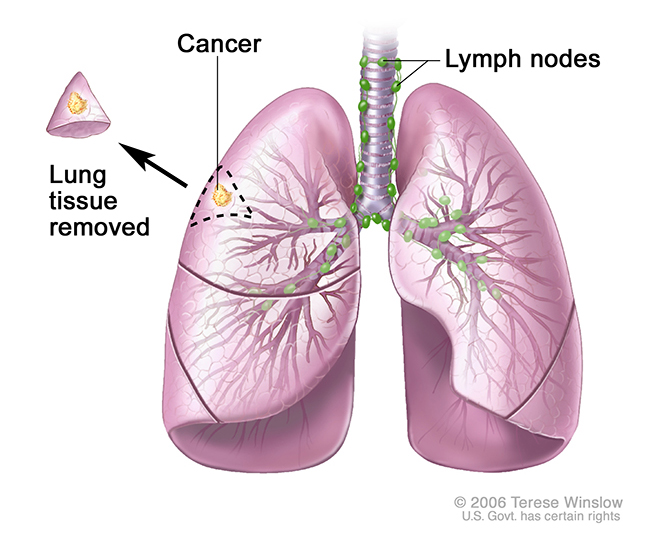Lung Cancer Treatment

The lung cancer specialists at the OHSU Knight Cancer Institute use the most advanced tests and therapies to diagnose and treat your cancer.
- Your care team will use molecular analysis to pinpoint your type of lung cancer and effective therapies.
- Our specialists work as a team to make sure every option and clinical trial is considered for your care.
- Our surgeons are experts in minimally invasive surgeries that preserve more of your lung and speed your recovery time.
Your treatment options will be based on your lung cancer type and stage, your general health and other factors.
Radiation therapy
Radiation therapy uses high-energy beams to shrink or destroy tumors. Most OHSU lung cancer patients have four to six weeks of radiation, combined with chemotherapy, to shrink tumors before any surgery. Radiation therapy can also be given during or after surgery. Types include:
- Stereotactic body radiation therapy: A machine sends a precisely focused beam to the tumor. The Knight Cancer Institute is the only Portland-area medical center with the extremely precise Novalis Tx radiosurgery system.
- Intensity-modulated radiation therapy: Computers and 3D images from CT scans help target tumors more accurately to lessen radiation to surrounding organs.
- Image-guided radiation therapy: Doctors use this therapy to track a tumor precisely. They adjust radiation to breathing and movement of the bladder and bowels. This limits exposure to healthy tissue.

Chemotherapy
Chemotherapy uses medications to kill cancer cells or to stop them from growing. It may be given as a pill or as an infusion (slow drip) into a vein or your spine.
- Before surgery: Chemotherapy given before surgery (neoadjuvant chemotherapy) can shrink a tumor or its spread.
- After surgery: Chemotherapy given after surgery (adjuvant chemotherapy) can kill cancer cells circulating nearly anywhere in your body.
- For advanced cancer: Chemotherapy can help control pain or other symptoms.
Bronchoscopy

Bronchoscopy lets us enter your lung without cuts. It can be used to treat a tumor blocking an airway in your lung.
The doctor guides a probe into your lung, finds the airway and places a stent (tube) to widen the airway. This does not cure the cancer but helps you breathe easier.
We use the advanced Ion robotic navigation system for exact placement with fewer side effects.
Immunotherapy
Immunotherapy uses the body’s immune system to slow tumor growth. Our team finds that immunotherapy helps many patients live longer and more comfortably. It can be given before or after surgery.
How it’s given: Immunotherapy may be given by pill or IV, sometimes along with other treatments. Some immunotherapies are available through clinical trials. Your care team will talk with you about whether a trial is right for you.
Specialty lung cancer clinic
The Knight’s multidisciplinary lung cancer clinic brings specialists together for patients who:
- Have had radiation, chemo, bronchoscopy or immunotherapy and are preparing for surgery
- Need complex care, especially for patients who live far away
At this clinic, patients meet with multiple specialists, have tests and get support services all in one visit.
- Specialists: Medical oncologists, radiation oncologists, thoracic surgeons and others as needed
- Tests: Pulmonary function test, blood and mucus tests, CT scan and others as needed
- Support services: Cancer nutrition services, lung cancer education, palliative care, social work
A nurse navigator helps each patient schedule and prepare for their first visit as quickly as possible. Visits to the multidisciplinary lung cancer clinic are on Fridays.
During your visit, we’ll discuss your care plan, including whether you may qualify for a clinical trial.
Surgery
Surgery removes cancer and nearby lymph nodes where cancer could spread. Your care team will recommend the best surgery based on your tumor's size and location as well as your overall health.
We use minimally invasive and lung-sparing techniques when possible, with tiny video cameras and tools. This offers less tissue damage, less pain, faster recovery and usually fewer complications.
Wedge Resection of the Lung

- Wedge resection or segmentectomy: A small wedge-shaped piece of lung is removed. This surgery removes less tissue than a lobectomy.
- Sleeve lobectomy: A lobe and part of its bronchus (the air passage that connects the lung to the windpipe) are removed. The remaining lobe or lobes are reconnected to the remaining bronchus.
- Thoracoscopic lobectomy: Surgeons thread a thin tube and camera through small incisions between your ribs. OHSU surgeons Mithran Sukumar and Paul Schipper pioneered this technique.
- Open lobectomy: Doctors use a chest incision to remove one lung lobe (the right lung has three lobes, the left two).
- Pneumonectomy: An entire lung is removed, leaving one healthy lung.
Clinical trials
We offer access to leading-edge clinical trials to test new ways to find and treat cancer. Patients get to try treatments that are otherwise not yet available.
Support services
Services to help you and your family include:
- Rehabilitation: Our rehabilitation experts can help you manage short- and long-term effects of cancer and cancer treatment.
- Palliative care: Our palliative care team can help you and your family manage symptoms and tough decisions. You do not need to end treatment or be terminally ill to receive services.
- Cancer social workers: Our social work team can provide counseling and other services to help you and your family cope. They can also help with transportation and lodging.
- Other services: Find links to additional services, including our guest house and pastoral care.
Learn more
- Non-Small Cell Lung Cancer Treatment, National Cancer Institute
- Small Cell Lung Cancer Treatment, National Cancer Institute
- Treating Non-Small Cell Lung Cancer, American Cancer Society
- Treating Small Cell Lung Cancer, American Cancer Society
Location
Knight Cancer Institute, South Waterfront
Center for Health & Healing, Building 2
3485 S. Bond Ave.
Portland, OR 97239
Free parking for patients and visitors
Refer a patient
- Refer your patient to OHSU.
- Call 503-494-4567 to seek provider-to-provider advice
Cancer clinical trials
Clinical trials allow patients to try a new test or treatment.
Read more
Learn more about OHSU Knight Cancer Institute treatments: